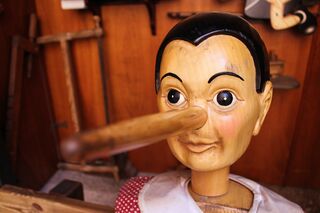Deception
The Psychology of Deception: Asking Questions to Spot Liars
Psychological science reveals several techniques for detecting liars.
Posted January 12, 2021 Reviewed by Gary Drevitch

Psychologists have long been concerned with how to determine when someone is telling a lie. The scientific literature on the topic of human deception is enormous, but so is the non-scientific ‘popular’ literature. Countless books have been written by ex-professional investigators and others, social media platforms offer thousands of apparently quick and easy techniques, and a multitude of training courses and manuals promise to provide information on how to accurately detect lies.
However, the message from the psychological literature on human deception is clear, and fairly consistent: There is no one reliable indicator of deception. Pinocchio’s nose does not exist in real life and one reason deception is so difficult to spot is that every liar behaves differently, but not necessarily differently than truth-tellers.
Some liars have been found to exhibit one or more, or none of, a wide range of physical and/or verbal behaviours, both continually and/or intermittently when lying, while others do not. For example, laughing and smiling, moving hands and fingers, self-touching (often referred to as self-adaptors), stuttering, gaze aversion, feigning a lack of memory, and taking a long time to answer questions have all been observed in liars, but not always. Furthermore, some or all of these behaviours are also regularly exhibited by truth-tellers, but again, not always.
Generally speaking, research reveals that humans are not good at detecting deception. People usually perform at around chance, and so may as well toss a coin, a finding consistent for both members of the public and professionals. Psychologists believe this may be, in part, because people have a truth bias and so do not ‘look’ for lies in everyday interactions, while professionals have been found to exhibit a lie bias and look too hard for indicators of lying. Biases such as these interfere with the way people understand the world around them, which in turn affects their decisions and judgments.
People are, however, often far better at spotting when a family member or another person they are very familiar with is being deceptive. Here, people can sometimes recognise that the person is behaving differently, or that something isn’t quite right, which can alert them to deceit. Indeed, parents are often able to detect when their children are being deceptive significantly above chance because children's truthful behaviour is well known and regularly observed, so changes in these usual behaviours immediately seem odd.
While psychological research lays bare numerous, enduring, and significant challenges of accurately detecting lies, the literature also offers guidance on how to improve one's chances of spotting a liar, even when that person is unfamiliar. Verbal cues are known to be far more diagnostic of deception than physical behaviours or body language. Relying on body language alone interferes with our ability to accurately detect deception because it is not a reliable cue.

But because lying is typically more mentally demanding than telling the truth, this extra mental load can be exploited to improve the detection of deception. Research reveals several effective questioning approaches for detecting lies. These techniques have emerged from laboratory work, and, more recently, using immersive gaming to effectively mimic the real world plus working in the field alongside professionals and members of the public in real security contexts.
Ask the right sorts of questions. Words are carriers of deception, and so every question should elicit as many words as possible. This means, wherever possible, ask open questions. For example, ‘Tell me all about your time living in New York’, rather than, ‘You say you lived in New York’. The former elicits a fuller more detailed response. The latter is a closed question, and so will only usually be answered with a ‘yes’ or ‘no’.
Make every question count. Don’t ask pointless questions just for the sake of saying something. Rather, ensure that every question moves you towards your goal, which is to understand the truth of what people are telling you.
Be tactical. If you are aware of objective facts, consider asking a question about each fact before revealing that you know the answer. This will allow you to understand whether that person is being generally truthful or not. Then, when you ask questions that you do not know the answer to, you will have some knowledge about how the person behaves when being truthful, or otherwise.
Listen rather than talk. Questioners should say as little as possible, to give themselves time to listen, think, and fully understand responses to their questions. Make every question count and ask as few as possible.
Be conversational and enquiring rather than aggressive, formal and accusatory. Questioning a person constitutes a complex social interaction, which will often be more pleasant and far more productive if questioners are able to engage with people in an information-gathering manner.
Include some temporal element to your questions. Switching between past, present, and future intentions can often be so mentally demanding for liars that they inadvertently reveal their deception by making errors, contradicting themselves, and/or contradicting objective facts known by the questioner.
Ask clarification questions. These types of questions probe for more detail about a previous answer or initial account. Liars can struggle with detail, and can also be inconsistent when recapping or repeating detail.
Even with the use of these psychological techniques, spotting liars remains challenging. But real-world research has revealed that performance can improve significantly when these approaches are put together and systematically applied when asking questions.
Facebook image: fizkes/Shutterstock
References
Bogaard, G., Meijer, E. H., Vrij, A., & Merckelbach, H. (2016). Strong, but wrong: Lay people’s and police officers’ beliefs about verbal and nonverbal cues to deception. PloS one, 11(6), e0156615.
Dando, C. J., & Bull, R. (2011). Maximising opportunities to detect verbal deception: Training police officers to interview tactically. Journal of Investigative Psychology and Offender Profiling, 8(2), 189-202.
Dando, C. J., & Ormerod, T. C. (2020). Noncoercive human intelligence gathering. Journal of Experimental Psychology: General, 149(8), 1435–144
Ormerod, T. C., & Dando, C. J. (2015). Finding a needle in a haystack: Toward a psychologically informed method for aviation security screening. Journal of Experimental Psychology: General, 144(1), 76.
Sandham, A. L., Dando, C. J., Bull, R., & Ormerod, T. C. (2020). Improving Professional Observers’ Veracity Judgements by Tactical Interviewing. Journal of Police and Criminal Psychology, 1-9.




